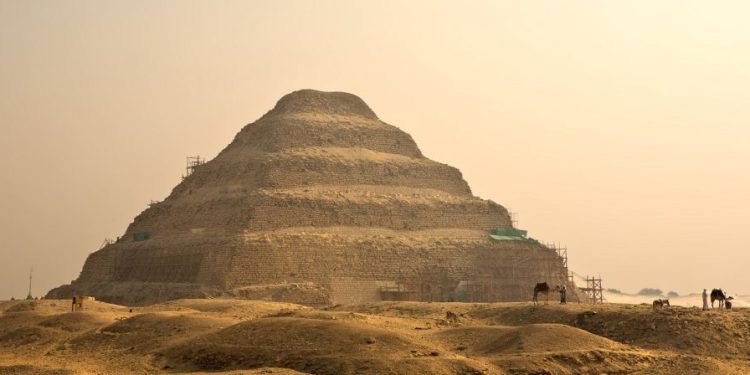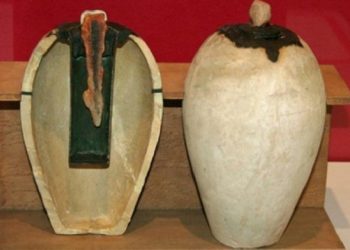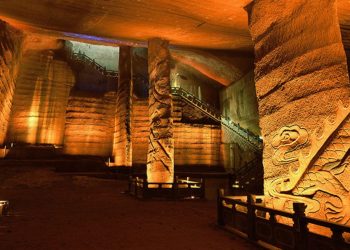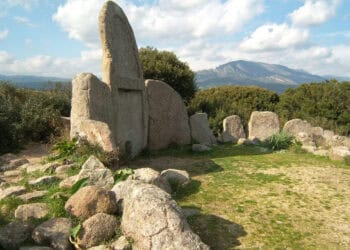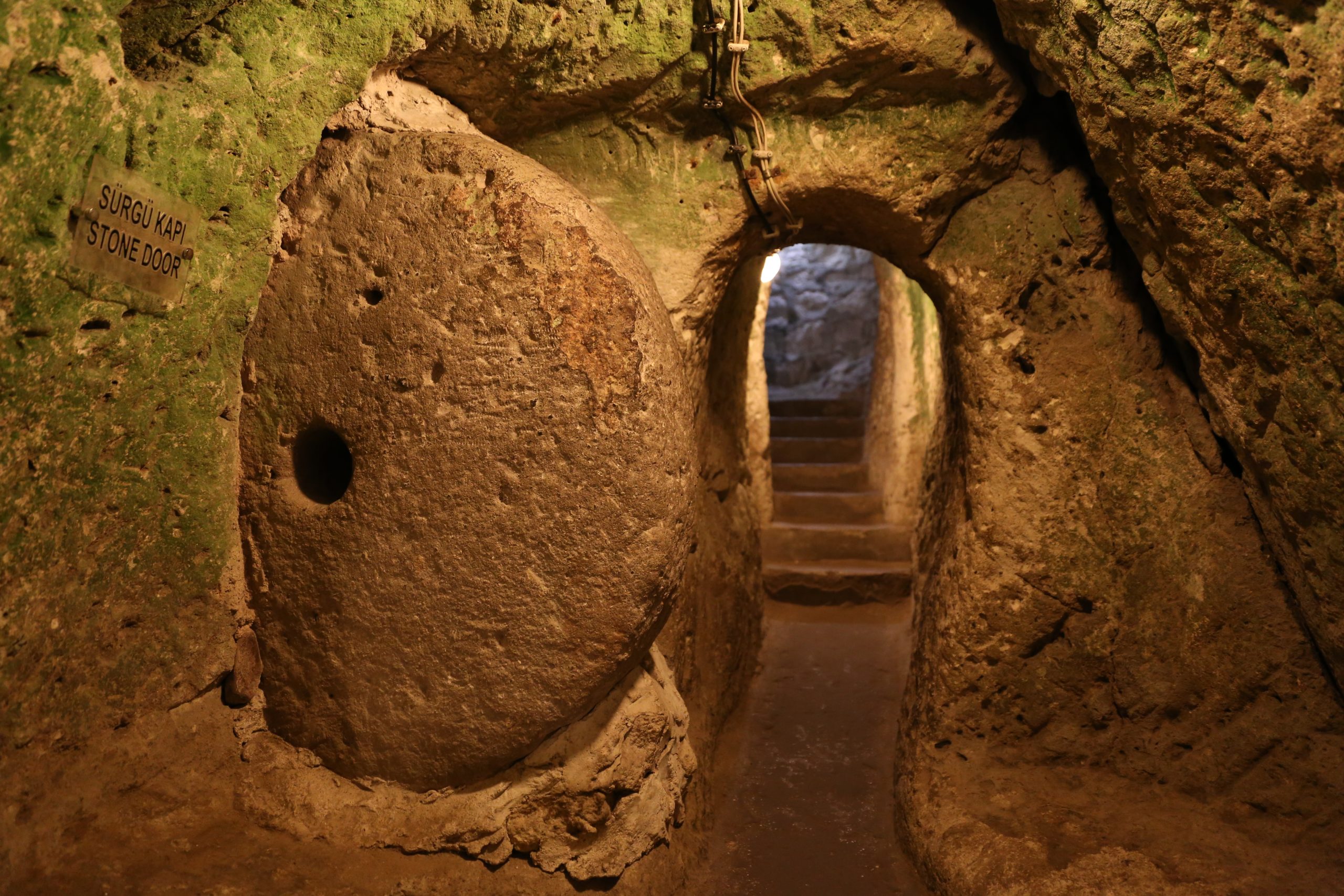Thousands of years ago, a man called Djoser ruled over the land of Egypt. Mainstream Egyptologists placed his reign around 4,700 Years ago, during a period often referred to by academics as the Third Dynasty of Egypt. But Djoser was unlike his predecessors, at least regarding innovations. More specifically, architecture. Djoser and his royal vizier and architect Imhotep are directly credited by scholars as having revolutionized ancient Egyptian architecture. In this article, we will go through a0 key facts about the Step Pyramid of Djoser, a structure believed to be the first Egyptian pyramid ever built.
The “invention” of the first pyramid?
During the reign of King Djoser, Egypt is believed to have “invented” the first pyramid. The history behind the construction of this majestic monument is anything short of extraordinary, but as all get things, this took time to complete. According to mainstream experts, the Step Pyramid of Egypt was built across six stages. This was completed in no more than 19 years, meaning that Djoser probably lived—long enough to see his master plan come to life.
An eternal resting place?
Although many scholars believe that the Step Pyramid of Djoser was built as the eternal resting place for the Pharaoh, many authors and experts disagree. Nonetheless, the accepted academic regarding the exact purpose of the pyramid remains that it was a tomb. After the death of the Pharaoh, his mummified body was placed beneath the pyramid. Referred to in ancient times as “the most sacred,” the pyramid is currently known as the stepped pyramid of Djoser. According to Manetho, it was built by Imhotep, the first architect, and engineer with a known name in history.
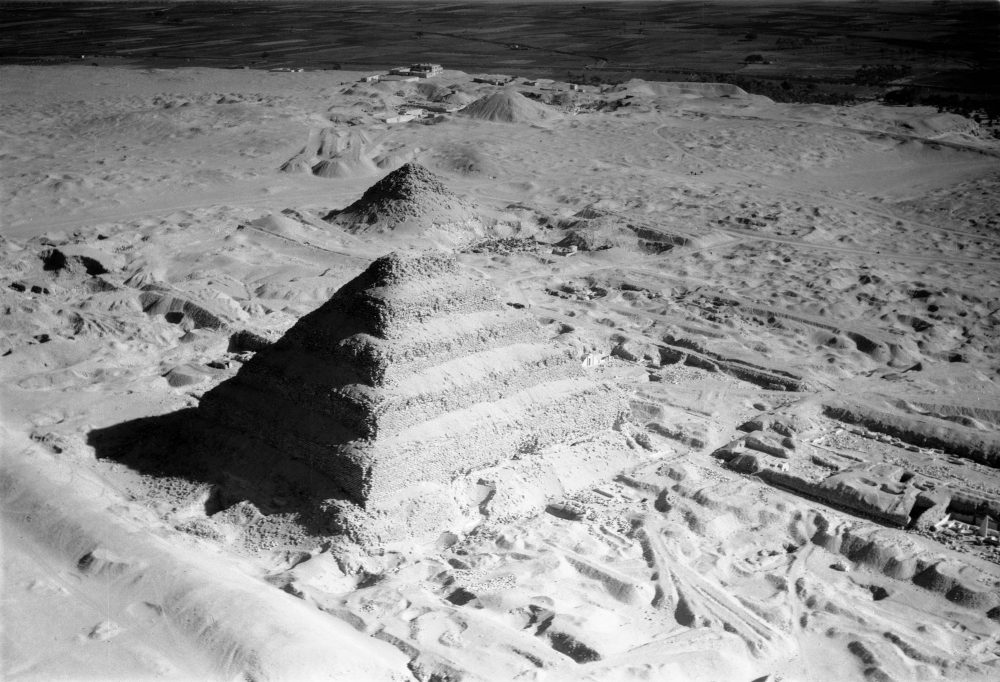
The Step Pyramid, a Jewel at Saqqara
This ancient jewel is, without a doubt, the most notable structure at the royal Necropolis of Saqqara, located south of the more popular Giza pyramids. Djoser’s Step Pyramid is regarded as the earliest prototype for a pyramid and a structure that would eventually give rise to more elaborate, complex, and larger stone structures. This is why it is commonly referred to as a proto-pyramid, an experimental structure that would eventually give rise to a different type of stone building in Egypt.
It was part of a larger pyramidal complex, surrounded by a stone wall that housed a temple and buildings of a symbolic character, most of them massive and inaccessible, with a large courtyard to commemorate the Heb Sed and an intricate system of underground galleries and warehouses. It is this massive subterranean world, perhaps the greatest “unknown” feature of the Step Pyramid. According to estimates, the subterranean world built beneath the Step Pyramid of Djoser measures a stunning 5.7 kilometers long. Beneath the pyramid are hundreds of rooms, storage spaces, galleries, and tunnels that together form an unfathomable subterranean labyrinth of a unique kind.
The Step Pyramid facts
It is so massive, complex, and intricately built that never again in the story of ancient Egyptian pyramid building would such an endeavor be attempted. Not even Egypt’s largest pyramid, the Great Pyramid of Giza, features such a massive and complex subterranean world. But let us slow down for a moment and attempt to trace its origins in history. Egyptologists usually say that until the construction of the pyramid of Djoser, royal tombs consisted of underground chambers covered by a truncated pyramid-shaped adobe structure called a mastaba.
The pyramid of Djoser is made of stone. It consists of six huge mastabas, one on top of the other, in the original plan’s six distinctive revisions and developments: a mastaba with a square base, 63 meters on a side, and eight meters high. There is some confusion here about who started the Mastaba that would give rise to the pyramid. Some theories suggest that the mastaba that was eventually turned into a pyramid was built before Djoser, but inconclusive evidence supports this.
From Mastaba to pyramid?
Given the fact that the initial mastaba—part one—of the pyramid of Djoser was square, and there are no square mastabas in Egypt, experts tend to agree that the leading architect of the project never meant to create a mastaba and that he already had planned a far more majestic monument. I will explain the stages involved in building the pyramid of Djoser later on in the article.
Since no written accounts exist of when the pyramid of Djoser is said to have been built, we can’t know how the entire process is unwinded and what sort of tools, equipment, and transportation means the ancient Egyptians used to build the pyramid. Whatever they used, they created a building that had never before been attempted, which is revolutionary and awe-inspiring. The earliest records of excavations belong to Prussian Consul-General von Minutoli, who explored parts of the ancient structure in 1821. That is around 4,500 years AFTER the pyramid was built.
Von Minutoli managed to penetrate some of the subterranean galleries, where he came across one of the blue-tiled chambers. In the pyramid, von Minutoli also found a mummified foot—which archeologists say may have belonged to Djoser, but there is no evidence to support this—and inscriptions that refer Netjerikhet. Not much is known about Netjerikhet—Djoser.
The Name Djoser
His name was closely associated with a region south of Aswan, known to the ancient Greeks as Dodekaschoinos. Djoser’s name and that of his royal architect are recorded in the Famine Stela, which dates back from the Ptolemaic Period, over 2,700 years after Djoser’s time. Djoser’s father is considered King Khasekhemwy, famous for introducing stone architecture to ancient Egypt. Strangely, and as revealed by Ahmed Fakhry in his work The Pyramids (p.23). The name “Djoser” does not occur on any monument before the Twelfth Dynasty. On his contemporary monuments, he is referred to as Netjerikhet or Iry-khet-Neter.
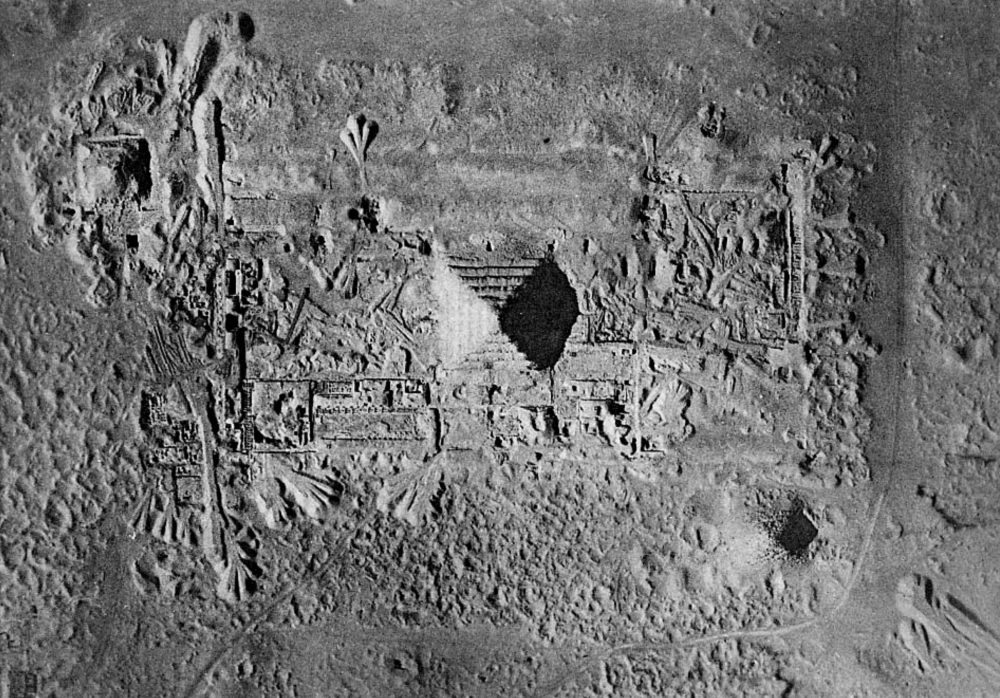
Although much of the above explains to a certain point the Step Pyramid of Djoser and how this unique monument came to be, below, I offer ten points that most of you have probably never heard of occurring in the Step Pyramid of Djoser.
Imhotep
Despite a lack of written documents of the time when the pyramid was built, it is believed that the Step Pyramid of Djoser was constructed by Imhotep, Djoser’s right-hand royal vizier and architect. This man would later be deified in ancient Egypt; people would pray to him for advice and healing. Imhotep was, therefore, not only the man believed to have birthed the pyramid but also very knowledgeable in various fields besides architecture and design.
Building a pyramid
The Step pyramid was an experimental structure, and its many stages attest to this. As revealed in Mark Lehner’s book, The Complete Pyramids, the Step Pyramid of Djoser was built in six distinct stages; M1, M2, M3, P1, P1′ P2. If the pyramid was built in nineteen years, and we divide the six stages by nineteen years, we obtain a new addition/restoration to the pyramid every three years. The many stages of the pyramid indeed suggest that the builders were experimenting with the structure.
Dimensions of the Djoser’s pyramid
The Pyramid of Djoser has a rectangular base (140 x 118 m), with its longer side running from east to west; It consists of six overlapping pyramid trunks with an original height of sixty-five meters. The inclination of the bodies of the pyramid is 16 ° from the vertical and 22 ° at the top level. the pyramid was cased with finely polished limestone. These stones are long gone and were likely used to construct other buildings during the New Kingdom.
Much larger than you think
Although the largest pyramid ever constructed in Egypt is the Great Pyramid of Giza, the Step Pyramid of Djoser is by no means small. The total volume of the Step Pyramid has been calculated at around 330,400 cubic meters (11,667,966 cu ft). This means that the pyramid of Djoser is even larger than Giza’s third-largest pyramid, the pyramid of Menkaure, which has an estimated total volume of 235,183 cubic meters (8,305,409 cu ft).
The earliest large-scale cut stone construction?
Hailed as one of the most revolutionary monuments in Egypt, the Step Pyramid of Djoser is also regarded as the earliest colossal stone building in Egypt and the earliest large-scale cut-stone construction made by man. This, however, is untrue for two main reasons. First, there’s a massive enclosure located not far from the Step Pyramid known as Gisr el-Mudir, which predates Djoser’s pyramid and is built almost entirely out of cut-stone. And secondly, the Pyramid of Djoser was built when halfway around the world; the civilization of Caral—in present-day Peru—also built massive stone pyramids, temples, and other structures. Furthermore, we can’t overlook another striking ancient monument that predates the Step Pyramid by several millennia; Göbekli Tepe, one of the largest ancient “stone” complexes known to man.
Evolution of the mastaba?
Egyptologists believe that the Step Pyramid is a direct evolution of the Mastaba tomb. The Step Pyramid of Djoser draws direct precedence of a mastaba at Saqqara, more specifically, Mastaba number 3038. The M1 stage of the Step Pyramid was a square mastaba. Since there are no square mastabas in Egypt, and mastabas are rectangular, Egyptologists say that Imhotep envisioned a mastaba-like structure but took the monument as is to another level, eventually stacking multiple “mastabas” on top of one another.
Is it meant to be a pyramid?
We don’t know what the architects of Djoser had in mind when they started building the structure we call the Step Pyramid today. It remains an enigma whether their initial plan was to build a step pyramid or whether the monument we see standing today was accidental. Perhaps the architects of Djoser were trying to “freshen up” the Mastaba tomb, which was in use since predynastic times. This may have led to stacking one mastaba atop the other, eventually resulting in the step pyramid.
A pyramid that would not be repeated
Although Djoser’s monument forever changed Egypt’s architecture, and one would expect that a long line of similar monuments would follow after Djoser, this was not the case. Although a few pharaohs that succeeded Djoser tried replicating the achievement of their ancestor, they never completed a pyramid, and only foundations of incomplete pyramids remain. When a new pyramid was eventually completed, it was not similar to that of Djoser. This was during the Fourth Dynasty reign of Sneferu.
Djoser’s subterranean world
Although the above-ground elements of Djoser’s spectacular pyramid compel are “out of this world,” what lies beneath the pyramid is worthy of the greatest admiration. Beneath the pyramid, and before the first “mastaba” was but, the builders were tasked with excavating a tunnel into the bedrock. This shaft eventually led to a massive underground labyrinth stretching around 5.7 kilometers. Such a massive subterranean world would never again be repeated in the long history of Egyptian pyramid building.
Artifacts beneath the pyramid
Although Egyptologists believe that Djoser was once buried beneath the pyramid inside the subterranean world, his mummy and his treasures are long gone. The pyramid’s interior is said to have been looted in ancient times, and the mummy and all previous artifacts were removed from the pyramid. Nevertheless, not all artifacts were stolen. Many artifacts were found inside the subterranean chambers when the pyramid was entered into modern times. The most noteworthy artifacts were a mummified foot (said to belong to Djoser), a hipbone of a female that predates Djoser by several generations, and as many as 40,000 stone vessels bearing the inscriptions of Djoser’s predecessors.
Join the discussion and participate in awesome giveaways in our mobile Telegram group. Join Curiosmos on Telegram Today. t.me/Curiosmos



